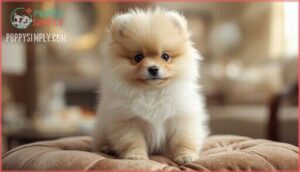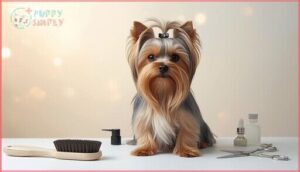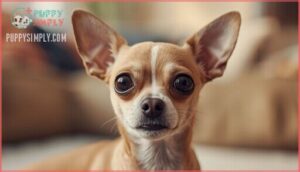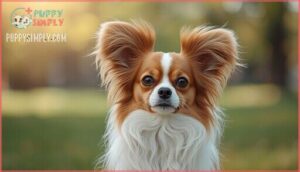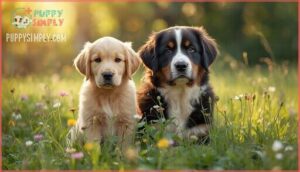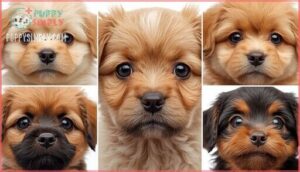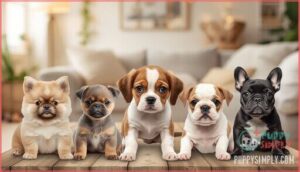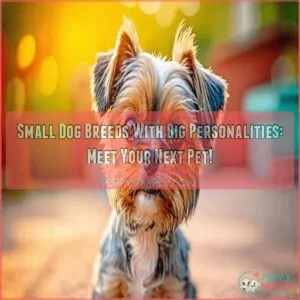This site is supported by our readers. We may earn a commission, at no cost to you, if you purchase through links.

But not all dogs wield this power equally. Some breeds have evolved features so precisely engineered for cuteness that they can melt hearts from across a room—big round eyes, floppy ears, and expressions that somehow communicate both innocence and mischief.
As a veterinarian, I’ve watched countless families fall for these irresistible faces, but there’s more to choosing the cutest dog breeds than just picking the one that makes you go "aww" the loudest.
Table Of Contents
- Key Takeaways
- What Makes a Dog Breed Cute?
- Small and Toy Breeds With Maximum Cuteness
- Medium and Large Cute Dog Breeds
- Unique Features That Enhance Cuteness
- Choosing The Right Cute Dog Breed
- Frequently Asked Questions (FAQs)
- Are all dogs cute?
- What are the Cutest Dog breeds?
- What is the smallest dog breed?
- Which dog breed is best for kids?
- What are the trends in the world of cute dog breeds?
- Are Bernese Mountain Dogs cutest dogs?
- Which cute small dog breeds do well in apartments?
- Are there any cute dog breeds that don’t bark much?
- What are the best cute dogs for people with allergies?
- How long do cute dog breeds typically live?
- Conclusion
Key Takeaways
- Looking at cute dogs triggers the same brain response as seeing human babies, flooding your system with oxytocin and making it biologically difficult to resist their appeal—especially breeds engineered with big round eyes, floppy ears, and expressive faces.
- Cuteness isn’t just aesthetic; it’s a survival mechanism that evolved through domestication, with dogs developing unique facial muscles to create puppy-dog eyes that trigger caregiving instincts and boost adoption rates by 35-40% in shelters.
- Choosing a breed based solely on appearance backfires quickly—grooming demands, exercise requirements, health issues (like brachycephalic breathing problems in flat-faced breeds), and space needs matter far more than Instagram-worthy looks once the novelty wears off.
- Small breeds like Maltipoos and Pomeranians need surprisingly intensive care (weekly grooming, dental maintenance, training to prevent "small dog syndrome"), while larger "cute" breeds like Golden Retrievers require 2+ hours of daily exercise and face serious health concerns like cancer prevalence shortening lifespans to 10-12 years.
What Makes a Dog Breed Cute?
You’ve probably caught yourself grinning at a dog’s face and wondered what exactly made your heart melt. There’s actually some fascinating science behind why certain breeds make us want to scoop them up and never let go.
Let’s break down the three main factors that turn dogs into living, breathing cuddle magnets.
Physical Traits That Trigger Affection
There’s something magnetic about dogs with big, round eyes—studies show they’re rated up to 70% more appealing than their narrow-eyed cousins. You’re responding to what scientists call the "baby schema": those oversized peepers, small noses, and rounded faces trigger a dopamine rush in your brain.
Add floppy ears, fluffy coats, soft textures, and that signature bouncy puppy gait, and you’ve got the recipe for cuteness overload—all part of Dog Breed Physical Traits that make certain breeds irresistible.
Interactions with dogs also trigger oxytocin hormone release, deepening the bond between humans and their canine companions.
Cuteness and Survival Instincts
That adorable face isn’t just for show—it’s a survival tool. When your dog gives you those big puppy eyes, oxytocin release floods both your brains, cementing the bond that kept their ancestors fed and safe. Domestication impact shaped dogs to read your facial cues and trigger emotional reciprocity.
Shelter data backs this up: dogs displaying expressive features see adoption rates jump 35–40%, proving cuteness literally saves lives in the cutest dog breeds. Dogs’ irresistible charm is often attributed to the baby schema, which triggers caregiving instincts in humans.
Personality and Temperament Factors
Looks alone don’t tell the whole story—dog breed temperament plays a huge role in perceived cuteness. Breeds with high human sociability and gentle personalities, like Cavalier King Charles Spaniels and Golden Retrievers, consistently rank as crowd favorites.
Genetic influence accounts for up to 15% of dog personalities, but environmental impact—socialization, training, owner style—shapes the rest.
Age variations matter too: younger pups bring peak energy, while middle-aged dogs mellow out. Even sex differences show up, with females generally more sociable and males more energetic.
Small and Toy Breeds With Maximum Cuteness
If you’re looking for portable excellence, small and toy breeds pack an enormous amount of charm into pint-sized packages. These little dogs have features that naturally trigger our nurturing instincts—think oversized eyes, compact faces, and personalities that far exceed their physical size.
Here are seven breeds that prove the cutest things really do come in small packages.
Maltipoo
If you’re hunting for a teddy bear that breathes, the Maltipoo might just steal your heart. This Crossbreed Genetics marvel—pairing a Maltese with a Toy Poodle—delivers that cloud-soft, curly coat in white, cream, or apricot, plus those round, soulful eyes that make saying "no" nearly impossible.
- Hypoallergenic Qualities: Low-shedding coat suits allergy-prone households beautifully
- Apartment Living champion: Weighing just 5–20 lb, they thrive in cozy spaces with moderate activity
- Training Needs are manageable: Smart, eager-to-please pups respond well to positive reinforcement
You’ll spend roughly $50–100 every 6–8 weeks on grooming costs to prevent matting, but their affectionate, loyal nature makes them top-tier family-friendly dog breeds. With a 10–15 year lifespan, these small dog breeds truly rank among the cutest dog breeds you’ll meet.
Pug
With those wrinkled faces and squishy features, Pugs embody their Latin motto, "a lot in a little." Their playful, even-tempered vibe and sociable charm make them irresistible, but as a vet, I’ll be honest: these adorable dogs require attentive care.
| Care Area | Frequency | Key Details |
|---|---|---|
| Wrinkle Care | Daily | Clean and dry facial folds to prevent infections; bacteria and yeast thrive in moisture |
| Dental Brushing | Daily | Crowded teeth invite disease; daily brushing is essential |
| Coat Brushing | Weekly minimum | Heavy year-round shedding despite short coat |
| Nail Trimming | Every 2–3 weeks | Prevents posture problems and discomfort |
| Ear Cleaning | As needed | Use vet-approved solutions to avoid otitis externa |
Pug Health comes with a reality check: their median lifespan is around 10 years, with brachycephalic airway issues, seizures, and hip dysplasia (up to 69.7% prevalence) being major concerns. Their Breed History dates back to Chinese imperial courts, but Popularity Trends are shifting as awareness of flat-faced health challenges grows, steering adopters toward less compromised breeds.
Temperament Traits are where Pugs truly shine: affectionate, low-aggression, and Playful Dogs that respond well to positive reinforcement. Neutered Pugs live roughly 3 years longer (11 vs. 8 years), so early spaying or neutering is recommended. These Small Dog Breeds and Wrinkly-faced Dogs demand commitment, but their goofy expressions and loyal companionship make every vet visit worthwhile.
Pomeranian
Those fluffy clouds of energy aren’t just Instagram gold—Pomeranians need real commitment. This Toy Breed ranks 18th in U.S. Popularity Trends but demands grooming three times weekly to prevent matting in that dense double coat. Pomeranian grooming includes monthly winter baths and frequent summer cleanings.
Health issues like patellar luxation (6.5% prevalence) and Alopecia X require vigilant care. Their temperament traits—bold, intelligent, alert—make these Small Dog Breeds confident watchdogs despite weighing just 3–7 pounds, living 12–16 years with proper management.
Yorkshire Terrier
That silky, steel-blue coat isn’t just for show—Yorkshire Terrier grooming demands daily brushing and professional trims every 4–6 weeks to prevent matting. Yorkie origins trace back to 19th-century England, where Scottish weavers bred these toy breeds for mill rat control before they became affectionate dog breeds.
- Size Guide: Adults weigh 4–7 pounds, standing just 7–8 inches tall
- Temperament: Spirited, confident, and surprisingly protective despite their tiny frame
- Health Issues: Dental disease, portosystemic shunt, and anesthesia sensitivity require vigilant care
Their big-dog attitude in a pocket-sized package makes Yorkies one of the cutest dog breeds, living 12.5–14.3 years with proper coat care and routine dental maintenance.
Chihuahua
Those enormous eyes aren’t just heart-melting—they’re one reason Chihuahuas rank as the most popular dog breed in 21 U.S. states. This tiniest of small dog breeds packs serious personality into a 3–7 pound frame, making them ideal for apartment living with proper socialization.
Breed popularity has surged fivefold in the UK since 2005, but these cutest dog breeds need consistent training to prevent "small dog syndrome." Females generally outlive males by 3+ years, with lifespans averaging 8–12 years depending on preventive care and weight management.
| Characteristic | Details |
|---|---|
| Size Variations | 15–23 cm tall, 0.8–9.8 kg weight range |
| Temperament Traits | Alert, loyal, protective—sometimes territorial |
| Health Concerns | Heart disease (18.8%), dental issues, hypoglycemia |
| Care Needs | 20–30 minutes daily exercise, routine dental care |
Papillon
Those butterfly-shaped ears aren’t just adorable—they helped Papillons rank among the top ten most intelligent dog breeds, mastering commands faster than breeds ten times their size.
At 6–11 pounds, these affectionate toy breeds need daily brushing to prevent mats in their silky coats, plus 30–45 minutes of exercise to stay sharp.
Common health issues include patellar luxation and dental disease, but with proper care, these playful small dog breeds often live 14–16 years—longer than most toys.
Shih Tzu
Originally bred as lapdogs for Chinese emperors over a thousand years ago, the Shih Tzu origin traces back to royal courts where they symbolized loyalty and elegance.
These affectionate dog breeds weigh 9–16 pounds, with round faces and flowing double coats requiring daily brushing. Their friendly temperament makes them ideal family companions, though dental disease affects over 13% due to their brachycephalic structure.
Expect 12–13 years with proper grooming care.
Medium and Large Cute Dog Breeds
If you’re looking for a dog that’s cute and has some size to them, you’re in luck. Medium and large breeds can be just as adorable as their tiny counterparts—they just come with more dog to love.
Here are seven breeds that prove cuteness doesn’t have a size limit.
Golden Retriever
Regarding Golden Cuteness, few breeds match this lovable companion. Golden Retrievers rank third in U.S. Popularity Ranking as Family-Friendly Dog Breeds, thanks to their unbeatable combination of soft eyes, wavy coats, and gentle temperament.
Here’s what makes them stand out in Dog Breed Characteristics:
- Temperament Traits: They score in the top 15% for friendliness and trainability—perfect for families with young kids.
- Exercise Needs: Plan for at least 2 hours daily of physical and mental activity to keep them happy.
- Dog Breed Temperament: Their bite inhibition rate stays under 10%, making them exceptionally safe around children.
- Breed Health: Unfortunately, cancer prevalence has shortened lifespans to 10–12 years, so regular vet checkups are essential.
Their people-pleasing personality puts them among the Cutest Dog Breeds you’ll ever meet.
Labrador Retriever
Labs reclaim their #1 spot in U.S. Breed Popularity for 2025—and it’s easy to see why. Their Labrador Appearance (big expressive eyes, otter tails, water-resistant coats) practically defines the Cutest Dog Breeds list.
Labrador Temperament scores 4.8/5 for friendliness, making them top Family-Friendly Dog Breeds.
Plan for an hour of daily Exercise Needs—these Puppies love swimming and fetch.
Health Concerns include hip dysplasia and obesity, so watch their weight closely.
French Bulldog
French Bulldogs topped U.S. popularity rankings through 2024, but their bat ears and squishy faces come with serious health concerns. Over 80% require C-section due to narrow hips, and brachycephalic issues mean breathing struggles and low heat tolerance—plan short walks and air conditioning.
Despite a recent decline in registrations, their temperament traits—affectionate, playful, and velcro-dog loyal—make them irresistible, family-friendly dog breeds for apartment life.
Cocker Spaniel
Those big, droopy ears aren’t just adorable—they’re also a health liability. Cocker Spaniels rank high among family-friendly dog breeds with affectionate, playful temperaments and moderate exercise needs (60 minutes daily). But their cute characteristics come with grooming needs every 6–8 weeks and ear infections topping their health issues list at nearly 14%.
What makes Cocker Spaniels irresistible:
- Silky feathered coats that beg for belly rubs
- Soulful eyes that melt your heart instantly
- Eager-to-please trainability for families with kids
- Compact 20–30 pound frames perfect for cuddles
- Wagging-tail enthusiasm that brightens every homecoming
Beagle
Those droopy ears and soulful eyes make Beagles one of the cutest dog breeds, with hound origins dating back to 16th-century England. Their scent-tracking abilities and pack instincts create friendly, curious personalities perfect for family-friendly dog breeds. But you’ll need patience with training needs—they howl, follow their noses relentlessly, and can be stubborn. Health concerns include ear infections and obesity risks.
Their tricolored coats and wagging tails embody cute dog characteristics—just keep snacks secured and fences high.
| Beagle Essentials | What You Need to Know |
|---|---|
| Size | 13–15 inches, 20–30 pounds |
| Lifespan | 10–15 years average |
| Exercise | 1–2 hours daily minimum |
| Grooming | Low-maintenance, occasional baths |
| Temperament | Affectionate, vocal, food-motivated |
Bernese Mountain Dog
Those thick tricolor coats and soulful expressions make Bernese Mountain Dogs irresistible gentle giants with Swiss origins tracing back to farm work in the canton of Bern.
You’ll love their calm, affectionate temperament—perfect for family compatibility and patience with kids.
But health concerns like hip dysplasia and shorter lifespans (7–10 years) require commitment. Their fluffy dog breeds status means regular grooming to manage heavy shedding and prevent matting in their silky, double-layered coats.
Australian Shepherd
With their striking merle genetics and mesmerizing heterochromatic eyes, Australian Shepherds rank among the cutest dog breeds while boasting remarkable intelligence—top 10 worldwide.
Consider these key dog breed characteristics:
- Strong herding instincts mean they’ll naturally "work" your family members
- Exercise needs demand 1–2 hours daily of vigorous activity
- Their merle coats come in blue, red, black variations with unique markings
- Separation anxiety affects roughly 17–23% due to deep owner bonds
- Cognitive engagement reduces destructive behaviors by 50%
Their fox-like dog breed appearances and athletic builds capture hearts, but these active companions thrive with space and mental stimulation.
Unique Features That Enhance Cuteness
You know that instant "aww" reaction when you see a dog? It’s not random—certain features have evolved to melt our hearts on sight.
From those big puppy eyes to coats that beg to be touched, these traits work like magnets for human affection.
Let’s break down exactly what makes some dogs scientifically irresistible.
Big Eyes and Soulful Expressions
Ever wonder why you can’t resist those soulful puppy-dog eyes? During domestication, dogs evolved unique facial muscles that let them raise their inner eyebrows—something wolves rarely do. This creates that heart-melting expression that triggers your caregiving instincts.
Dogs evolved eyebrow muscles wolves lack, creating expressions that hijack our caregiving instincts on sight
Breeds like Cocker Spaniels and Shih Tzus rank among the cutest dog breeds partly because their larger eye-to-face ratios heighten emotional intensity. When you lock eyes with your dog, oxytocin surges in both of you, creating a bonding loop. That’s the oxytocin-gaze loop at work—making breed eye variations and dog breed appearance matter for connection.
Cultural eye perception varies, but most agree: soulful-eyed dogs win hearts everywhere.
Floppy Ears and Wrinkly Faces
Floppy ears and wrinkly faces aren’t just adorable—they come with real health tradeoffs. Breeds like Bloodhounds and Basset Hounds use those droopy ears for scent tracking, trapping odor particles near the nose. But poor ventilation means 25-40% of floppy-eared dogs face ear infections annually.
Wrinkly-faced dogs like Shar-Peis and Bulldogs need diligent wrinkle care to prevent skin fold dermatitis, which affects up to 25% of these breeds. While breed standards celebrate these features and social media loves their dog appearance, health costs run 20-40% higher than non-wrinkly breeds. Cuteness has its price.
Fluffy and Curly Coats
Fluffy and curly coats are nature’s insulation masterpieces—but they demand serious upkeep. Double-coated breeds like Samoyeds reduce heat loss by 80% in cold climates, while curly-haired dogs like Poodles shed 70–80% less dander, making them hypoallergenic favorites.
Your grooming demands vary by coat composition:
- Daily brushing for long fluffy dogs prevents matting and keeps skin healthy
- Weekly deshedding during coat-blow seasons twice yearly for breed adaptations
- Professional grooming every 4–8 weeks for curly-haired dogs maintaining coat thermoregulation
Fluffy dogs like Great Pyrenees evolved dense undercoats for survival, while curly breeds trap less airborne fur—perfect for apartments.
Fox-like and Teddy Bear Appearances
Beyond fluff, some dogs look uncannily like foxes or living teddy bears—features rooted in Spitz heritage and neotenic traits. Fox-like breeds such as Pomeranians (1.8–3 kg) and Finnish Spitz display pointed ears, narrow muzzles, and dense double coats. Teddy bear dogs—hybrids like Shichons—boast rounded faces, curly hypoallergenic fur, and weigh 6–14 pounds. Their anthropomorphic charm drives breed popularity among urban owners.
| Feature | Fox-like Breeds | Teddy Bear Dogs |
|---|---|---|
| Size | 1.8–50 kg (Pomeranian to Akita) | 6–14 lbs (toy class) |
| Coat Type | Dense double coat, plumed tail | Wavy/curly, hypoallergenic |
| Face Shape | Narrow muzzle, pointed ears | Rounded, brachycephalic |
| Temperament | Alert, independent, vocal | Sociable, biddable, gentle |
| Examples | Finnish Spitz, Shiba Inu, German Spitz | Shichon, Malshi, Teacup varieties |
Choosing The Right Cute Dog Breed
Picking the right cute dog isn’t just about falling for a fluffy face or big puppy eyes. You need to think about your lifestyle, living space, and how much time you can dedicate to grooming and exercise.
Let’s break down what matters most so you can find a breed that fits your home and keeps both of you happy.
Family-Friendly and Loyal Breeds
When you’re looking for a dog that’ll bond with your whole crew, breeds like Golden Retrievers and Labrador Retrievers consistently top the charts for loyalty and child compatibility. These family-friendly dog breeds aren’t just adorable—they bring real emotional impact, with studies showing Lab interactions can drop stress levels by 31%.
Training benefits come easy too, since affectionate dog breeds like Poodles score above 90% in obedience. Adoption rates reflect these breed trends: over half of owners would pick the same loyal companions again.
Grooming and Care Needs
Once you’ve picked your loyal companion, dog grooming and care needs vary widely by breed. Small breeds like Poodles and Shih Tzus need professional grooming every 4–6 weeks, while short-coated dogs like Beagles manage with visits every 8–12 weeks.
Dog care essentials include:
- Coat maintenance – Brush curly breeds daily; double-coated dogs need de-shedding tools
- Dental hygiene – Brush small breeds thrice weekly (73% of dogs face dental disease)
- Ear cleaning – Check floppy-eared breeds weekly for infections
- Paw care – Trim nails every 3–4 weeks to prevent gait problems
Grooming costs average $35–$90 per session, with annual dog care expenses reaching $1,390–$5,295 depending on your breed’s coat complexity.
Energy Levels and Exercise Requirements
After sorting through grooming schedules, you’ll want to match your lifestyle to your dog’s stamina. Sporting breeds like Labradors need around 90 minutes of vigorous exercise daily, while companion breeds like Pugs thrive on shorter walks.
High-energy dogs like Border Collies require 1–2+ hours of intense activity to prevent destructive behaviors from under-stimulation.
Puppies need gentler sessions to protect developing joints, and seniors benefit from low-impact swimming to maintain mobility.
Apartment Vs. House Suitability
Since space shapes behavior, you need to evaluate breed behavior alongside your square footage. Small dog breeds under 20 pounds adapt well to apartments, needing just 9–12 square feet indoors, while Labradors require 24–36 square feet plus yard access.
Consider these lifestyle factors for apartment living:
- Space requirements: Toy breeds like Chihuahuas thrive in compact units; large breeds need houses with outdoor areas
- Breed behavior: Calm French Bulldogs suit shared-wall housing better than vocal Terriers
- Legal restrictions: Many apartments cap weight at 25–50 pounds, blocking family-friendly dog breeds like Retrievers
- Urban amenities: Access to dog parks increases feasibility of keeping active breeds in multi-unit dwellings by 32%
Apartment-dwelling dogs average 1.2 daily walks versus 2.4 for house pets, making low-energy breeds more practical choices.
Frequently Asked Questions (FAQs)
Are all dogs cute?
Cuteness is surprisingly subjective—what melts your heart mightn’t do the same for someone else. While breed stereotypes exist, individual variation means every dog has unique characteristics that appeal to different dog lovers.
Owner bias plays a huge role too; you’ll naturally see your own pup as adorable, regardless of typical dog appearance standards.
What are the Cutest Dog breeds?
You’ll find adorable dog breeds across every size category—from pocket-sized Chihuahuas with their apple-shaped heads to fluffy Golden Retrievers with soulful eyes.
Cuteness perception varies, but breed popularity consistently favors dogs with infant-like features: big eyes, round faces, and expressive personalities that trigger our caregiving instincts.
What is the smallest dog breed?
The Chihuahua claims the title of smallest dog breed, usually weighing under six pounds and standing just five to eight inches tall.
These pocket-sized pups originated in Mexico and pack bold personalities despite their tiny frames.
Which dog breed is best for kids?
Labrador Retrievers, Golden Retrievers, and Cavalier King Charles Spaniels excel with kids—they’re patient, gentle, and tolerate chaos.
These family-friendly dog breeds show low bite incident data and high trainability, making them ideal family pets with kid-safe temperaments.
What are the trends in the world of cute dog breeds?
French Bulldogs dominated popularity from 2022–2024, but Labs reclaimed the top spot in Social media drives breed demand—over 54% of buyers are influenced by Instagram-worthy looks.
However, breeding for cuteness brings health risks: brachycephalic breeds face respiratory issues and costly surgeries.
The market’s booming, projected to hit $94 billion by 2027, while ethical concerns grow alongside prices ranging from $1,000 to over $5,
Are Bernese Mountain Dogs cutest dogs?
Bernese Mountain Dogs certainly rank among the cutest dog breeds, thanks to their expressive brown eyes, symmetrical rust-colored eyebrows, and thick tri-color coats.
These gentle giants combine a striking dog appearance with affectionate temperament factors, making them ideal for family suitability despite significant grooming needs and space requirements.
Which cute small dog breeds do well in apartments?
If you live in an apartment, Pugs, Pomeranians, and Yorkshire Terriers are all solid choices. They’re small dog breeds with manageable exercise needs—usually 15 to 60 minutes daily—and don’t demand much space.
Training ease helps control barking habits, which matters for close neighbors.
Are there any cute dog breeds that don’t bark much?
Yes—some adorable breeds are naturally quieter. Basenjis rarely bark, French Bulldogs stay calm in apartments, and Cavalier King Charles Spaniels are gentle and quiet.
Pugs, Maltese, and Bichon Frises also tend toward lower barking with proper training and socialization.
What are the best cute dogs for people with allergies?
Unfortunately, no dog breeds are truly hypoallergenic. Scientific evidence shows that allergen production doesn’t vary much across breeds, regardless of coat types.
However, some small dogs like Poodles, Bichon Frises, and Maltese shed less, which might help reduce airborne allergens when paired with regular grooming.
How long do cute dog breeds typically live?
Breed lifespan varies considerably by size correlation—smaller dog breeds like Pomeranians often reach 15 to 20 years, while larger breeds like Golden Retrievers average 10 to 12 years.
Genetic factors and breed-specific health issues heavily influence longevity, making proper care strategies essential.
Conclusion
Here’s the truth nobody tells you: picking one of the cutest dog breeds isn’t about choosing the fluffiest face or the biggest eyes—it’s about finding a dog whose needs match your lifestyle before those puppy-dog eyes convince you otherwise.
That oxytocin rush wears off around 3 a.m. when your underprepared Pomeranian is yapping at shadows. Choose based on energy, grooming demands, and space requirements, not just Instagram potential.
Cuteness opens the door, but compatibility keeps it from slamming shut.
- https://www.salon.com/2022/06/26/the-20-cutest-dog-breeds-according-to-science_partner/
- https://www.akc.org/most-popular-breeds/
- https://www.petpalaceresort.com/statistics-on-the-most-popular-dog-breeds/
- https://pmc.ncbi.nlm.nih.gov/articles/PMC7616237/
- https://timesofindia.indiatimes.com/life-style/relationships/pets/top-10-most-instagrammable-dog-breeds-in-america/photostory/124084728.cms



